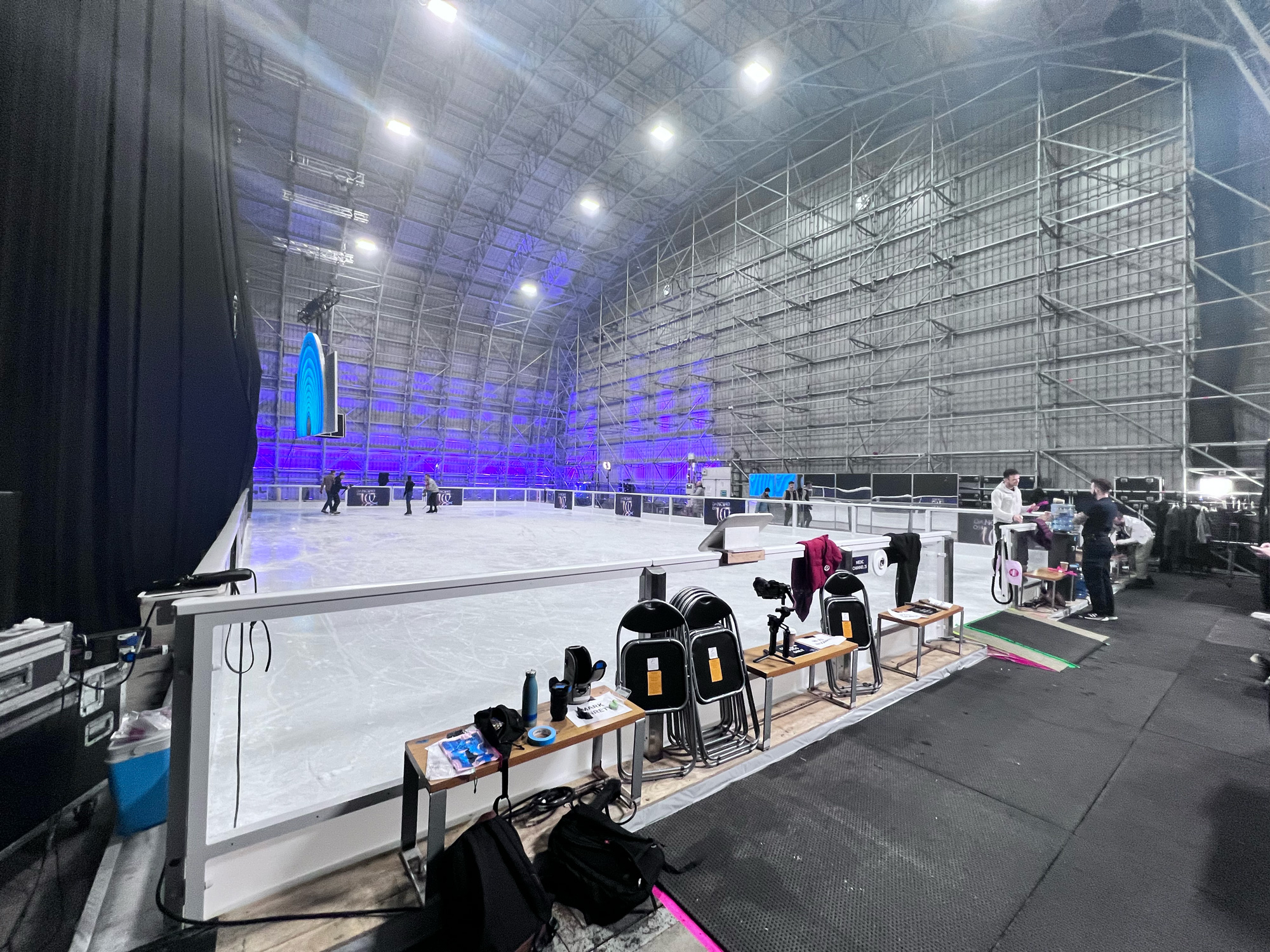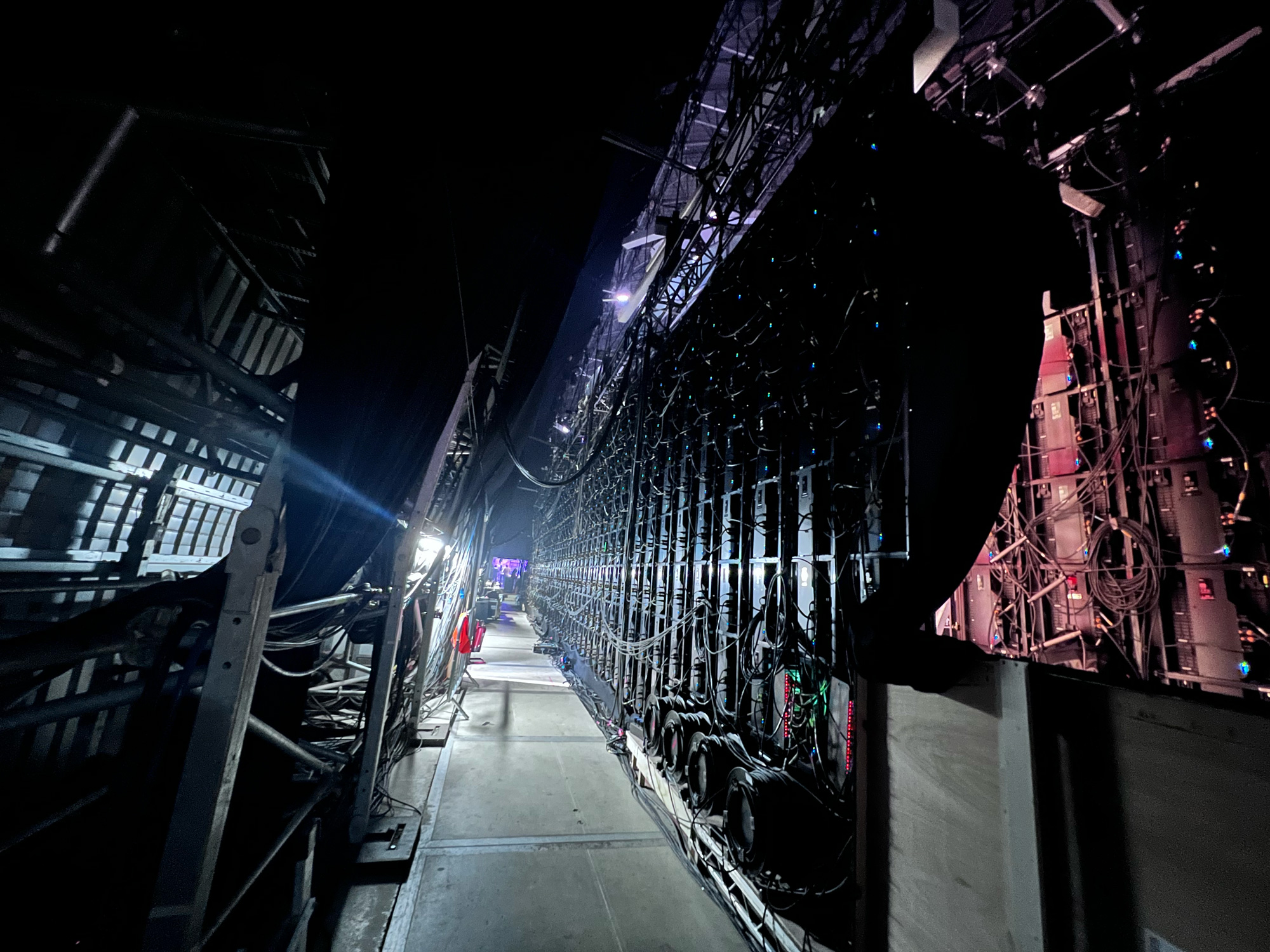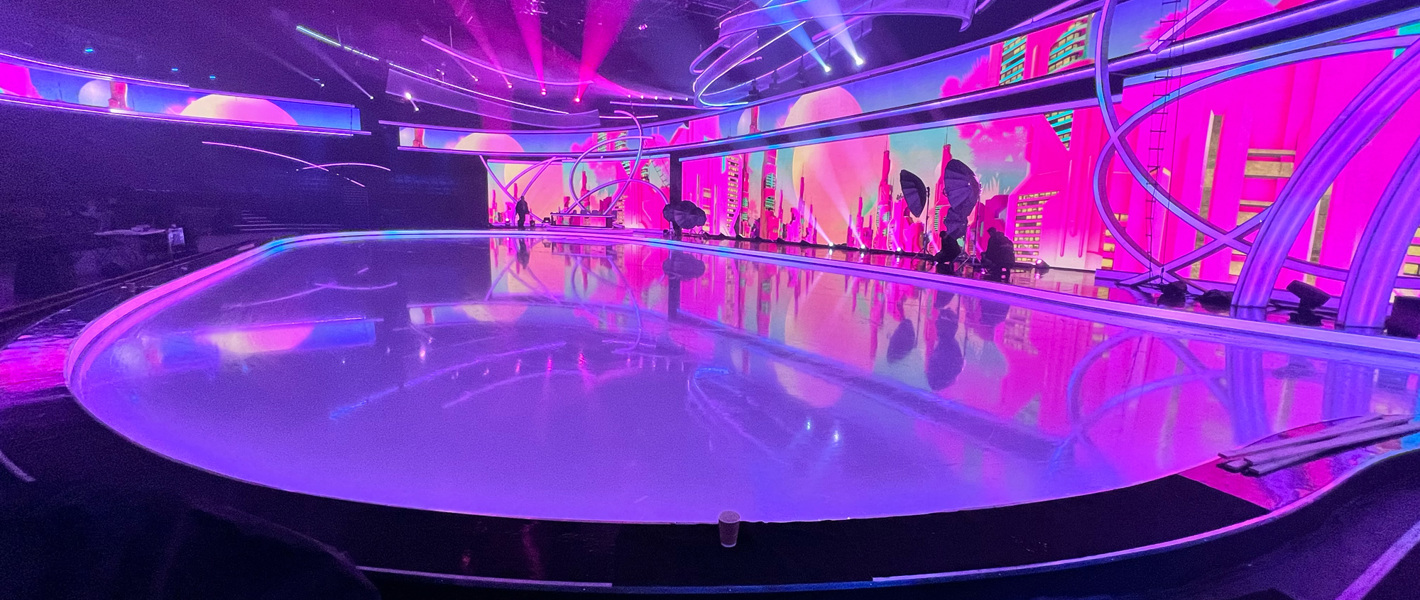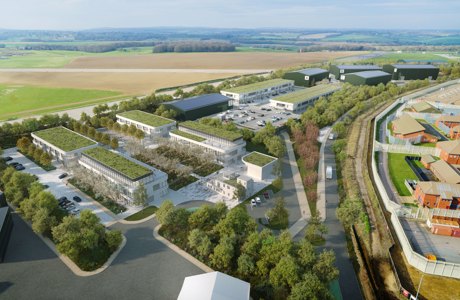We’re on the eve of the end of the latest series of Dancing on Ice, the final of which is thisSunday 10th March from 6:30pm on ITV1. So, we thought we would team up with ITV Studios Bovingdon to tell you more about how the show is made and how it was revived on site atBovingdon Airfield Studios in 2018.
This current series 16 has been filming every weekend since the middle of January, and it’s the 7th series filmed with us here at Bovingdon. Read this article to find out more about finding and building the studio, hear from Mark Hanretty about dancing on the show, discover how they create the perfect ice rink, all about the show’s creative production, lighting and pyros, and how the amazing ice camera operator films alongside the dancers.

Finding Bovingdon
Dancing on Ice first hit our screens back in 2006, and was filmed elsewhere prior to the show finishing in 2014 for a few years. By 2016, ITV were looking to bring it back and tasked Jeanette Moffat and her team at Lifted Entertainment to find a new studio home for the show. The task was challenging and they were struggling to find the right space, as Dancing on Ice is a particularly complex production to both house and maintain with requirements more suited to film than TV studio spaces.
Those requirements were threefold. Firstly, a vast amount of space for multiple ice rinks, a live audience and an extensive production team. Secondly, a sufficiently strong weight-bearing floor to take the load of the rinks, ice machines, and a multitude of technical equipment. Thirdly, at least 15metres of height, to fit multiple dancers carrying other dancers high above their heads during stunts, while always providing sufficient distance between the roof’s hot lighting and the cold ice beneath. As we saw in last week’s semi-final, many of the tricks also include performers flying high above the main rink.
Building ITV Studios
The answer was to create a custom-built studio that could house ice rinks at Bovingdon Airfield Studios, and thus ITV Studios Bovingdon was born. Jeanette describes the solution as “literally perfect” owing also to the privacy at the site coupled with acres of hardstanding surface from Bovingdon’s plentiful backlot space and runways. After meetings in May 2017, the first structure was completed in record time by the October. Another benefit of Bovingdon is its proximity to Central London for the competing celebrities and production team to travel.
They also knew that having built such a high spec studio to meet the demands of Dancing on Ice, it would also suit any other production, particularly large scale entertainment shows as well as TV drama and feature films. As a result, many other shows have also filmed there including Starstruck and The Wheel, even managing to fit an entire train carriage and a Chapel into the studio - for Amazon’s ‘The Power’ and Sky’s ‘This is Christmas’. Accordingly, ITV Studios Bovingdon has proved to be a successful and versatile studio space - suitable for TV or film.
Creating the perfect ice
ITV hires a dedicated ice company to build and maintain its rinks for filming; iSkate run by ice engineer and expert Neil Munn, and his team Alan, Hannah, Laurie, Natalie and Will. iSkate has designed and overseen rinks at all the major UK sites, including places such as Somerset House, The Gleneagles Hotel, and Edinburgh. There are 3 rinks in the Dancing on Ice studio; the main studio performance rink, a training rink, and an ice tunnel connecting the two. The training rink is specifically designed to be the exact same size as the main studio rink so the skaters can better train and prepare for the show.
The scale of the ice operation is both huge and incredibly intricate. 19 km of piping and 90,000 litres of water are used to create the rinks, with up to 6,000 litres of water used daily, and 3 massive chillers stationed outside. Owing to the risk of potential leak points, the almost 4,000 pipework and equipment fittings have to be cleaned by hand. They even build two layers of white mesh into the ice to make it appear brighter white and help the cameras bounce back light to work better with the projections. They also use warm water instead of cold to produce clearer ice.

Pro dancers were struggling at one point with the ice surface owing to the level of chalk in the local water, which led Neil and his team to design and implement their own unique filtration system to rid the water of impurities through reverse osmosis. Consequently, what’s laid down is purer than rain water, and also specially deoxygenated so it can freeze faster. The feel of the ice to the touch is like perfectly smooth glass. The celebrity contestants and their pro dancer partners all train on the training rink, so the ice they train on is what they also perform on during the live shows.
Accordingly, they are skating on the most perfect possible rink in terms of quality, which has always been noted by judges and ice skating legends Jayne Torvill and Christopher Dean, as well as guest judge and American figure skating Olympian Johnny Weir.
Maintenance of the profile of the ice is a critical, complex and all consuming endeavour. The ultimate goal is to achieve perfect thermal uniformity across all the rinks at all times, while consistency of grip, feel and speed is also paramount. Consequently, Neil always has at least 2 members of his team beside the ice, constantly striving for optimal surface consistency, depth and temperature. If it’s too cold it’s like skating on steel, and too soft then wading through slush. The ice depth is checked at regular intervals using a handheld laser, and temperature with a thermal gun, alongside gauges throughout the building.
The entire studio is run cooler during the week, with the temperature rising at the weekend for comfort during the live show - and also owing to the influx of hundreds of people (c. 700).
Their Zamboni resurfacing machine is uniquely able to operate in a simultaneous threefold capacity; sweep snow, lay water, and cut ice. The ice is also carefully monitored throughout each period of skating so the iSkate team knows which areas might require additional attention. Weekly on Mondays and Thursdays they conduct a massive wholesale “re-setting” process; 2 hours with a pressure pump that can drop 6-7,000 litres of water in 30 minutes. This floods the entire surface to create perfect fresh ice ready for the weekend’s rigorous training schedule; 3 rehearsals every Saturday, 2 before lunchtime on show day Sunday, a dress rehearsal and then ultimately the evening’s live show. Wherever possible, electric and clean energy is also used with sustainability an important factor.
The maintenance process steps up a gear during the live shows, with members of Neil’s team sweeping across the ice during every filming break examining it and clearing any items detached from costumes - with sequins being particular culprits.
The aim is for flawless ice every day throughout the series, from the moment the rinks are ready in early December right up until the last skater leaves the ice after the final wraps. At that point, the chillers are then almost immediately switched off and the thawing process begins.

Mark Hanretty - Pro Dancer
We had the opportunity to speak to Mark Hanretty, one of the pro dancers on the show who is also competing in the final this weekend with his celebrity partner - reality TV personality and DJ Adele Roberts. Mark is a veteran performer on Dancing on Ice, having appeared on it since 2011 following a hugely successful professional ice skating career. He was inspired to start skating after watching Torvill and Dean return to competitive skating in 1994, and now has a role pro dancing on the show alongside his childhood heroes.
Mark says the ice on the show is the best in the country, with the skaters somewhat spoiled owing to its superior quality. Furthermore, the fact the studio has been purpose-built provides additional benefits for the skaters as in the previous studios there was no training rink conjoined to the main show rink, requiring separate transport to and fro. The fact the two rinks are interconnected at Bovingdon enables the skaters to warm up during live shows and then glide straight through, thereby being more comfortable on the ice and in their skates leading up to their performance. Mark also feels “protected and cocooned in a Dancing on Ice bubble, and very well looked after” at Bovingdon, which he now - after 7 years filming the show here - regards as a “home from home” and his colleagues like “extended family”.
Mark and the other skaters spend a lot of time at the studios during the series. Initially doing 2 hours on the ice daily (limited owing to the potential for injury), before ramping up to 6+ hours with their celebrity partners plus additional pro-only training on their separate routines. It’s an extremely rigorous schedule, with Mark and Adele opting to do additional training owing to the fact that she isn’t from a performance or athletics background by profession. All the skaters then essentially live in the studio over the entire weekend in the run up to Sunday evening, training and working intensively with the Director to call the best shots.
The process of working with the celebrities on their skating is fascinating, as they have limited skating awareness but are specifically made performance ready with the assistance of the pro dancers. Mark is also a skating coach, with coaching as his mainstay job outside the show, so he is particularly adept at teaching and making others feel comfortable on the ice. He says the key is to provide a framework, and find strengths to play to. In the case of Adele, she isn’t a dancer, actress or performer, but she is incredibly conscientious and hard working. Therefore they have leaned into the skating skills aspect together throughout the series, and it has earned them a place in the final four.
Mark’s highlight this year has been being partnered with Adele. She has had to endure a horrific last few years, suffering with bowel cancer, undergoing chemotherapy and having a stoma, and then her mother dying just days before this year’s series started. Mark says “she takes such stoicism and positivity to life. She’s just incredible, and so inspiring. I would like to think that her inspiration lies deep as one of the highlights for everybody that has had the chance to work with her this year.”

The Ice Camera Operator
Dancing on Ice is one of a rare few remaining completely live TV shows, and as such requires a multitude of camera operators positioned throughout the studio. There’s a rail cam running along the ice periphery, and a team of operators who climb rope ladders just before going on air to be stationed high above the rinks, remaining there until the end.
However, it was decided several years into the show that an exciting additional way to capture the action on the ice was to have a cameraperson wearing a custom-rig skating alongside the performers. The current ice camera operator, James Tregaskis, has an impressive and rare dual expertise in both skating (as an ice hockey player) and also camerawork since childhood. Well before his time on Dancing on Ice, he experimented with filming while rollerblading in order to get more interesting tracking shots. James can skate just as naturally as he can walk, with the key to the role being complete confidence on the ice so he can fully concentrate on the camerawork. All the shots you see at home weaving in and around the performers on the ice are taken by James skating perfectly but also totally imperceptibly in sync.
Accordingly, James says the biggest challenge isn’t the ice or skating, it’s his own routine. In possibly one of the most difficult, involved and precision roles on the team, he has to train alongside all the dancers in order to remember every routine (8-13 per week), where the dancers will be on the ice at all times, where all the cameras are and which shots are being taken, and where the lights around the studio are all moving - so his shadow is never seen and he’s never caught on screen or in shot.
James often has to hide under or beside props, jumping out with exact timing to catch his own shots - close enough to get the best angles but not so much as to be distracting - before melting into the background. It’s a fascinating process to watch during live shows, as that’s the only time you will ever see him in action (if things are going to plan!).
I always have to be in exactly the right place at the right time… but it’s a huge team effort. I couldn’t do it without the help of the whole team working together.
- James Tregaskis
Lighting & Pyrotechnics
One of the most impressive structures in the studio are giant swathes of LED screens curving around the whole length of the back wall of the main show rink where the dancers perform. Reportedly the longest LED screen in Europe, on the reverse side there’s a floor to (almost) ceiling mass of intertwined ducting and black cables. Above, the roof is a mass of metal scaffolding and truss infrastructure scattered with lighting units and rigging.
The reason behind the huge LED wall is that it’s used to create entire backdrops and scenery. It’s important to keep the number and size of props on the ice to a minimum to help preserve it and reduce the potential for obstructions or accidents.
Therefore the team compensates by creating amazingly lifelike scenery through pyrotechnics on the wall. It’s the lighting and projection combined with the graphics that produces the incredible effects you see. A great example of which are the rooftops of Paris recreated for a pro dance from the 2018 series. This is new functionality that has been custom-built for the studio at Bovingdon. Frequently, hosts Holly Willoughby and Stephen Mulhern, along with other guest stars, appear to be standing or sitting as if floating atop the ice. An effect achieved through the use of special sections of white carpet and swirling smoke effects.

Creative Production
The attention to detail on the show is remarkable, and we were lucky to also speak to one of the show's two Creative Producers, Mitch Langcaster-James. His role is to come up with original ideas, manage them through the creative process, and ensure each is seamlessly executed live. The big picture overall theme cascades down through each celebrity-pro dance, also encompassing all additional performances such as opening sequences and guest acts.
He describes it as sparking the idea, watching it ignite and proliferate with all the valuable input from all the many departments - before being harnessed and focused back into a final cohesive and executable form, often involving many last-minute adjustments, which we then see on our screens at home. A particular highlight of his from this latest series was putting Claire Sweeney into a giant clam and having her sing live during her dance.
There’s a delicate balance to be struck between trying to be as big and bold as possible, within the time, budget and technical constraints of the show. This is managed through constant liaison, coordination and scheduling with all the different departments and individuals, including wardrobe, props, set pieces, lighting, SFX, pyrotechnics, and hair and make-up. They go backwards and forwards to agree every creative aspect down to the most minute details. The space available at Bovingdon is ideal for the Creative Producers, as they know logistics won’t hinder creativity; it enables them to think and dream big.

Bovingdon is like a little village. It’s got such a lovely feel. You know where everyone is in each department - we’re all here in one place, and it’s helpful having so much space. We’ve got the run of the place and scale is not a problem.
- Mitch Langcaster-James
Being Live & On Ice
The process is made all the more challenging owing to the number of contestants and performances, and the show being live (with an audience). And on ice. Yet, after so many years it's now at the pinnacle of professionalism in terms of operating like a well-oiled machine. Nevertheless, being live brings inevitable surprises with all moments recorded for everyone to see - in either their glory or agony - such as Gemma Collins crashing to the ice in the 2019 series.
Being live means the turnaround time for everyone involved is extremely tight. On the surface the show looks to be gliding through each section almost easily although with definite tempo, but this belies a huge logistical feat of organisation and collective effort. The pressure is always there, with Mitch describing “a huge feeling of time marching on. As soon as one performance is complete it’s on to the next one, and the next show”. The single inevitable fact is that the show will go on, with a countdown clock always ticking down to the final in March.
Having ice makes it even more of a unique working environment, much more complex than standard theatre or stage. Mitch explains, “once you put things on ice, there's restrictions as to what people can wear, what happens when costumes get wet… and we can't have certain things that touch the ice because they'll stick. It makes things so much more complicated.”
Finally
Helen Button, ITV Bovingdon’s Studio Manager, refers to the Dancing on Ice “family tree”, with everyone in the team being as important as the next, from the people managing security and parking at the entrance, to the compere inside the studio entertaining the live audience.
Bovingdon Airfield Studios and within it ITV Studios Bovingdon, provide a unique, large and private space within which the Dancing on Ice “bubble” gets created and everyone works intensively for months on end in order to make everything come together.
Thanks
Our sincere thanks to all the contributors to this article:
- Jeanette Moffat, Head of Production for Lifted Entertainment (part of ITV Studios)
- Helen Button, Studio Manager for ITV Studios Bovingdon
- Neil Munn, Managing Director of iSkate
- Mark Hanretty, Pro Dancer and Choreographer
- James Tregaskis, Ice-skating Camera Operator
- Mitch Langcaster-James, Creative Producer
ITV Studios Bovingdon
When Dancing on Ice completes Series 16 this weekend, there will be some studio availability for other productions. To find out more about the studio email helen.button@itv.com or call 020 715 74674
Visit ITV Studios Bovingdon Website
Bovingdon Airfield Studios
ITV Studios Bovingdon is part of Bovingdon Airfield Studios.
For more information email jo@bovingdonairfieldstudios.com or call 020 3327 0664.

